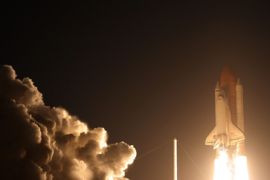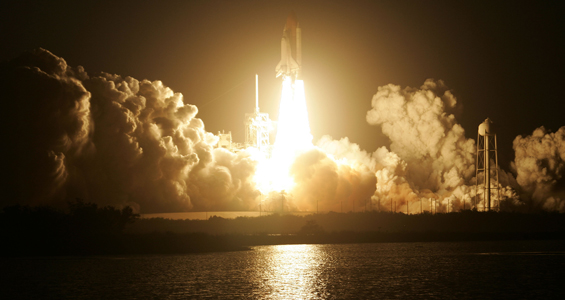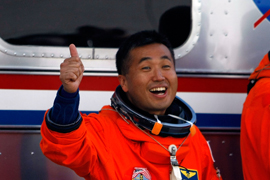Shuttle heads for space station
Discovery blasts off carrying first Japanese resident to International Space Station.

 |
| Nasa officials labelled Sunday evening’s launch as “flawless” [AFP] |
The space shuttle Discovery has blasted off from Cape Canaveral carrying a crew of seven including Japan’s first long-term resident of the International Space Station (ISS).
Koichi Wakata is expected to spend at least three months on the station, beginning work in Japan’s Kibo space laboratory which was installed last year.
Keep reading
list of 4 itemsRainfall set to help crews battling wildfire near Canada’s Fort McMurray
The Alabama town living and dying in the shadow of chemical plants
How India is racing against time to save the endangered red panda
Discovery blasted-off on its 13-day mission on Sunday evening in what Nasa officials said was a flawless launch, rising into the sky just as the sun was setting.
The mission had been due for launch in early February, but was delayed for more than a month by a problem with hydrogen valves.
The delay forced Nasa officials to cut the mission back from an originally planned 14 days to clear the shuttle from the station in time for the arrival of a Russian Soyuz capsule.
The shuttle is expected to dock with the space station on Tuesday.
Mission objectives
 |
| Discovery is carrying Koichi Wakata, the first Japanese resident at the space station [AFP] |
Discovery, making its 36th flight, is carrying a fourth and final set of solar wing panels to the ISS in what will be one of the last major steps in the decade-long construction of the $100bn station.
The installation of the panels is aimed at boosting the space station’s ability to generate electricity to about 120 kilowatts, enough to meet the planned expansion of the station’s crew from a current three astronauts to six.
Nasa officials say the expanded crew will finally allow the station to achieve its purpose of operating as a zero-gravity platform for scientific experiments.
The first of three spacewalks planned during Discovery’s mission to the ISS will be to install a truss segment containing the solar panels, worth $300 million and weighing 14,060kg.
The piece completes the space station’s 11-part, 102m backbone.
The astronauts will also deliver new parts for a water purification system that converts urine and condensates into drinkable water – a system that will be essential to support the expanded crew.
The purification system was installed during a shuttle mission in November but had stopped working.
Japanese resident
Discovery will also deliver Koichi Wakata, the first Japanese resident on the ISS, who will replace US astronaut Sandra Magnus.
An astronaut with the Japan Aerospace Exploration Agency (Jaxa), Wakata flew as the first Japanese mission specialist on a 1996 shuttle mission and has conducted two spacewalks.
He was the first Japanese astronaut to work on the ISS assembly on mission number STS-92 also flying on the Discovery shuttle in October 2000.
Wakata is expected to remain on the ISS until May working in the giant Japanese-built Kibo space lab.
Kibo, meaning hope in Japanese, is the largest single module attached to the ISS.
The $2.4bn laboratory, which includes a special “porch” for exposing is experiments to the vacuum of space, is so large that it required two separate shuttle missions last year to deliver it to the space station.